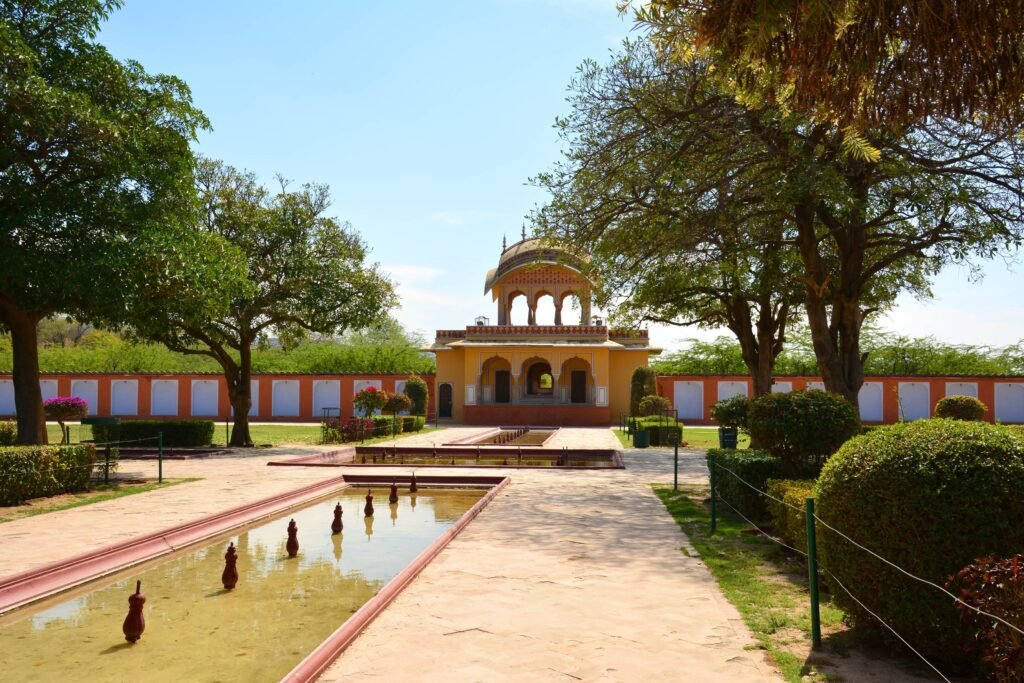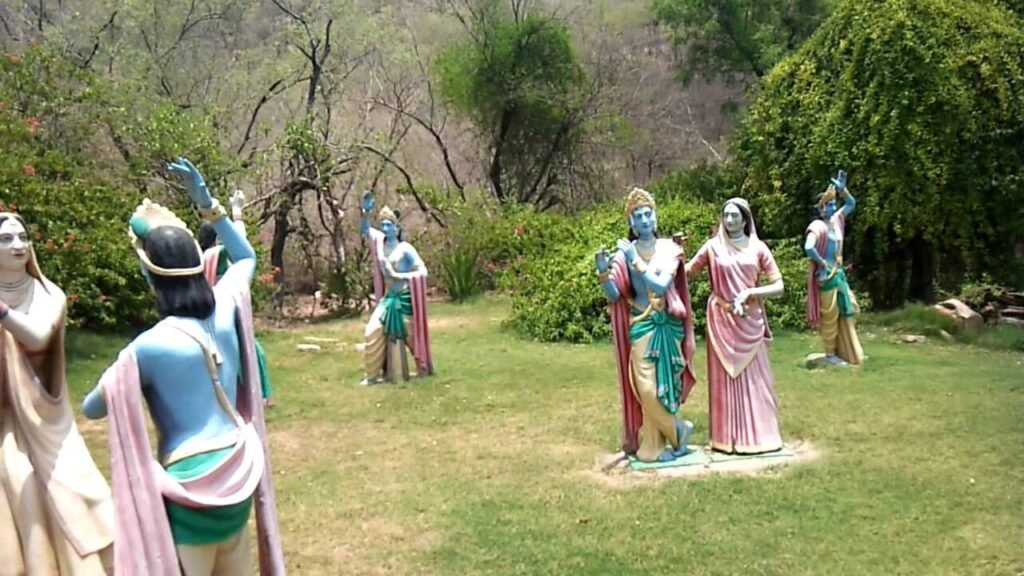Nestled in the lush valleys at the base of the Nahargarh Hills and surrounded by the Aravalli Range, Kanak Vrindavan stands as a serene oasis steeped in Rajasthan’s cultural, spiritual, and architectural heritage. Renowned for its breathtaking beauty and mythological connections, the garden echoes the soul of Vrindavan, the legendary playground of Lord Krishna, recreated for Jaipur’s royalty.
Key Details:
| Aspect | Details |
|---|---|
| Location | About 8–11 km from Jaipur city centre |
| Significance | Approx. 275 years ago, by Maharaja Sawai Jai Singh |
| Features | Eight-section Mughal-Rajput garden, marble fountains, temple (Govind Deoji), chhatris, carvings, scenic views |
| Built | Approx. 275 years ago by Maharaja Sawai Jai Singh |
| Entry Fee | ₹20 per person (may vary, sometimes free) |
| Visiting Time | 8:00 AM – 5:00 PM (all days), some reports till 6:30 or 7:00 PM |
| Time Required | ~1 hour |
| Best Months to Visit | October to March (pleasant weather) |
| Distance from Jaipur | Approx. 275 years ago, by Maharaja Sawai Jai Singh |
| How to Reach | Taxi, cab, private car from the city centre, local buses |
| Nearby Attractions | Amer Fort, Jal Mahal, Jaigarh Fort, Nahargarh Fort |
| Cost from Delhi | Flight: ₹2,800–5,500; Train: lower, plus local Jaipur transport |
| Photography | Usually allowed; may be free or a nominal fee |
| Facilities | Rest areas, lush lawns, fountains, a temple, and parking |
History of Kanak Vrindavan
Kanak Vrindavan was built nearly 275–280 years ago by Maharaja Sawai Jai Singh II, a visionary Kachhwaha Rajput king and founder of Jaipur. Drawn by the valley’s resemblance to mythological Vrindavan, the place where Lord Krishna played with the Gopis, the Maharaja conceived the garden as a tranquil retreat for himself and his queens.
The name itself is layered in history: “Kanak” traces origins to Maharani Kanakde, one of Jai Singh’s consorts, while “Vrindavan” highlights its spiritual link with Krishna lore.
A centrepiece of Kanak Vrindavan is the Shri Govind Deoji Temple, dedicated to Lord Krishna. The site became a locus for Ashvamedha Yagnas, with waters from sacred rivers transported to augment its religious significance.
Architectural Elegance and Layout
This garden is a marvel of Rajput landscaping and stonework. The central fountain, ‘Parikrama’, is carved from a single piece of marble, and its eight divided sections feature perfectly manicured lawns, intricate chatris (cenotaphs), latticework, mirrors, and jali (screen) designs. The Govind Deoji Temple within boasts an ornate Garbha Griha embellished with delicate “panni” work.
The garden’s layout was designed for both royal recreation and sacred congregation, offering panoramic vistas of Jaipur’s forts, including Amer, Nahargarh, Jaigarh, as well as the Dharbawati River. Bollywood has also often showcased Kanak Vrindavan’s enchanting scenery, making it a popular filming destination.
Culture and Mythology
Kanak Vrindavan is more than a horticultural wonder; it’s a living tapestry of spiritual legend and royal culture. By recreating Vrindavan in Jaipur, Maharaja Jai Singh linked his rule and family with eternal Krishna mythology. The garden thus hosts festivals, religious ceremonies, and cultural events that draw devotees and travellers alike.
The annual Janmashtami and Holi celebrations resonate with mythic stories, bringing the space alive with devotion and art. Its role as a pilgrimage and tourist site has made it vital to Jaipur’s economy, supporting handicrafts, hospitality, and seasonal tourism.
Location and Accessibility
Kanak Vrindavan is situated about 8 to 11 km northeast of central Jaipur, on the scenic Amer Road at the foothills of Nahargarh. Its coordinates are 26°57′48.83″N 75°50′50.60″E, and with Amer Fort, Jaigarh Fort, and Jal Mahal nearby, it’s ideal for heritage circuits.
How to Reach:
From Airport/Railway: Road transport is recommended, approximately 51 km from Jaipur International Airport and 23 km from the Railway Station.
By Road: Taxis, ride-shares, and local cabs easily connect visitors from Jaipur City Centre, requiring a 9–11 km or 15–20 minute drive by car.
By Bus: The Ajmeri Gate to Shahpura Bagh bus service operates every 20 minutes, taking approximately 32 minutes.
By Subway: Travel via Jaipur’s Pink Line to Badi Chaupar, then a short bus ride.
By Foot: For enthusiasts, walking the 8.9 km scenic route is possible but takes over 1 hour and 40 minutes.

Tourism and Economic Impact
The Kanak Vrindavan complex significantly contributes to Jaipur’s tourism, attracting both domestic and international travellers. Pilgrimage remains a cornerstone of the region’s economy, with temple tourism, local craft sales, food and beverage outlets, and hospitality playing pivotal roles.
- Entry fees and taxes aid local development.
- Festivals and special events spike seasonal revenue.
- Local businesses and transportation operators thrive on the steady stream of tourists.
The systematic preservation and improvement of infrastructure around Kanak Vrindavan have also contributed to Jaipur’s reputation as a leading cultural and pilgrimage destination.
Tourist Attractions Nearby
Kanak Vrindavan is surrounded by several famous spots:
- Amer Fort: Just up the road, a UNESCO World Heritage Site.
- Nahargarh Fort: Overlooks Jaipur and offers splendid views.
- Jaigarh Fort: Known for its history and cannon foundries.
- Jal Mahal: Picturesque palace in Man Sagar Lake.
- Elephant Park: Wildlife observation and conservation site.
Spectacular migratory birds such as spotted doves, Neel Kanth, and kingfishers are commonly sighted, adding to the garden’s biodiversity and ecosystem appeal.
Visitor Information
- Opening Hours: 8:00 am to 5:00 pm.
- Best Time to Visit: Winter and Spring, specifically January, February, March, and December.
- Entry Fees: Minimal, supports garden upkeep.
- Recreational Activities: Relaxing, nature walks, photography, picnics, spiritual retreats, and cultural programs.
The garden’s wide lawns and exquisite fountains make it perfect for a day’s relaxation, especially for families, couples, and groups seeking peace amidst nature. Online booking via cab services is advised for a hassle-free experience.
FAQs About Kanak Vrindavan
What is Kanak Vrindavan, and why is it famous?
Kanak Vrindavan is a historic garden complex in Jaipur, modelled after the mythological Vrindavan, with links to Lord Krishna and built by Maharaja Sawai Jai Singh. It is famous for its architecture, serene landscapes, and cultural significance.
How old is Kanak Vrindavan?
The garden is approximately 275–280 years old, established around the 18th century by Jaipur’s founder.
Where is Kanak Vrindavan located?
Kanak Vrindavan is located on Amer Road, at the base of the Nahargarh hills, about 8–11 km from Jaipur’s city centre.
What are the nearby attractions?
Amer Fort, Nahargarh Fort, Jaigarh Fort, Jal Mahal, and the Elephant Park are all nearby, making the area ideal for historical and cultural tourism circuits.
How can visitors reach Kanak Vrindavan?
Visitors can easily reach Badi Chaupar via taxi, road, local buses, or take the Pink Line subway to Badi Chaupar and then use connecting transport.
What is the best time to visit the garden?
The best time is during the winter and spring months (December to March), when the weather is pleasant, and the scenery is lush.
Does Kanak Vrindavan generate revenue for Jaipur?
Yes, through entry fees, festivals, hospitality services, and local commerce, Kanak Vrindavan contributes to Jaipur’s tourism-based revenue, supporting the regional economy.
Is Kanak Vrindavan open year-round?
Yes, apart from special maintenance days, the garden is open all year from 8:00 am to 5:00 pm.
